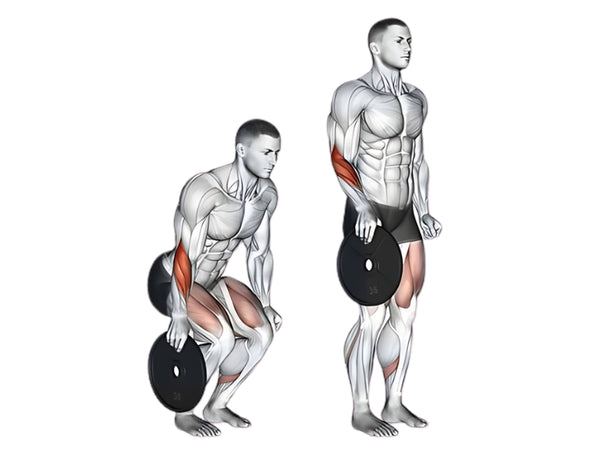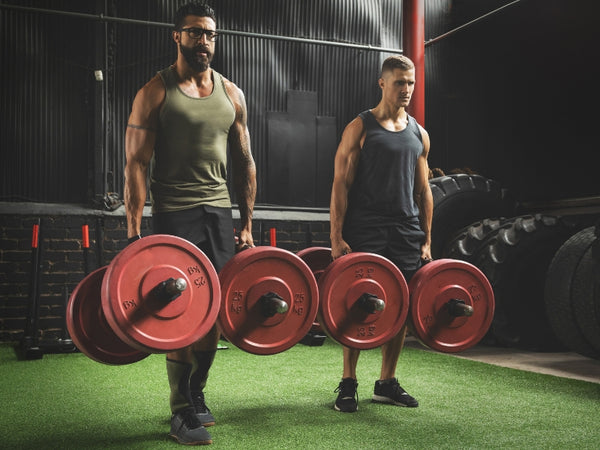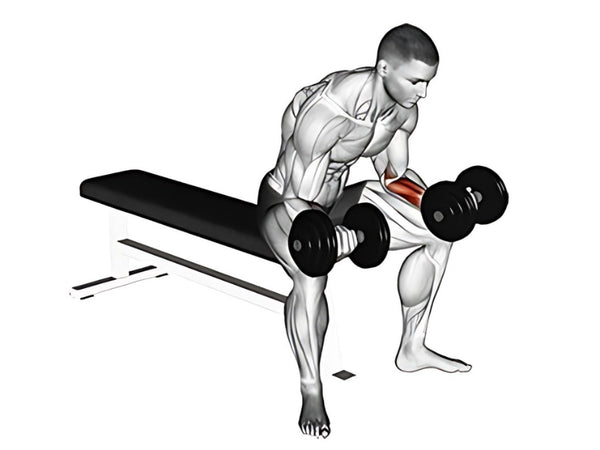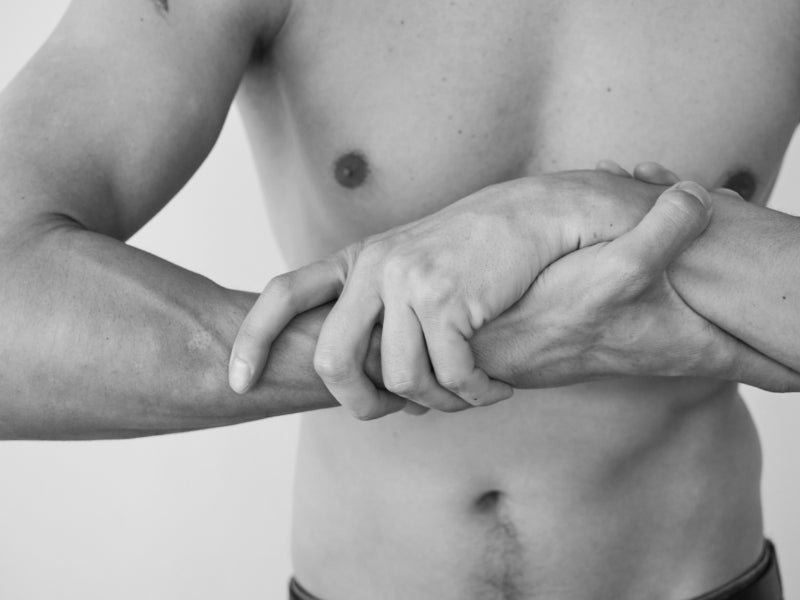Although often neglected at the gym, your forearms consist of many separate muscles, and they all need to be exercised. Having strong forearms is essential for grip strength, wrist mobility, and so much more.
That said, some people may not know how to exercise their forearms, and that's exactly what we're here to fix today. Let's get to it and take a look at nine of the best forearm workouts that you can do.
Why Use Dumbbells to Exercise Your Forearms?

Some people might be wondering why we are talking about using dumbbells to train your forearms. Well, there are several reasons for this. First and foremost, using dumbbells means that you get to work each arm individually.
Although you'll do most of these exercises with both arms at the same time, you're still technically working out each arm by itself.
This helps you develop your muscles evenly, preventing muscle imbalances from occurring. On the other hand, if you already have muscle imbalances, this allows you to work one arm a little harder than the other, therefore making up for the imbalance.
What's also nice about dumbbells is that they come in all sorts of weights, usually starting as low as 2.5 lbs, making them more than ideal for beginners. It's great for people engaging in progressive overload, and for those who want to increase the amount of weight they lift by very small increments over a long period of time.
Best Forearm Workouts with Dumbbells
Here we have a list of various forearm workouts or exercises that you can do at home or at the gym, depending on the equipment you have. Let’s take a closer look at all of the best ones.
1. Plate Pinches

The plate pinch is an excellent exercise to help grow both forearm strength and size.
- Start by choosing two weight plates that are the same weight. You'll probably want to start with something lighter, especially if you're not too experienced with this.
- Your feet should be shoulder width apart, and you should be holding a plate in each hand, with the palms of your hands facing each other using what is known as a pinch grip. The pinch grip involves your fingers holding the plate from one side and your thumb from the other. It's like pinching your skin, but pinching weighted plates.
- Lift the plates up and hold them for as long as you can, starting with 10 or 15 seconds, and then slowly progressing to a heavier weight.
- If you want to make things harder on yourself, you can always walk around while doing this exercise.
2. Wrist Abduction
If you want to improve the overall strength and size of your forearm muscles, while also improving the stability of your wrists, doing what is known as risk abduction is one of the best things for you.
- Sit or kneel down on the ground, and rest your forearms on a bench. Your palms should be facing down, and your wrists should be hanging over the edge of the bench.
- Take a pair of the lightest dumbbells you can find, hold them in your hands so that your palms are facing each other, and hold your arms about 8 to 10 inches apart.
- Now it's time to lift your wrists so that your thumbs face upwards and away from the body.
- Lower your wrist back down to the starting position and repeat this for anywhere between 8 and 12 reps.
3. Wrist Adduction
Whereas before we had wrist abduction, here we have wrist adduction. It's virtually the same exercise, and it has all of the same benefits, but in the other direction. It can also be done standing up or kneeling.
- Instead of sitting down with your arms on a bench, you'll do this exercise standing up.
- Hold the lightweight pair of dumbbells at your sides with your palms facing forward.
- Move your wrists inwards by moving your pinky upward and closer to your body.
- Repeat this for anywhere between 8 and 12 repetitions.
4. The Farmer’s Walk

If you're looking to enhance both the endurance and grip strength of your forearms, doing the farmer's walk is a great way to do so. The farmer’s walk is something that you can do with dumbbells, kettlebells, or weighted plates.
- Take a fairly heavy pair of dumbbells, as heavy as you can manage while holding them comfortably. If they're slightly hard to grip and you feel like they're a bit too heavy for you, then you're on the right track.
- Now it's time for you to go on a little walk. Start by doing about 20 steps in one direction, and then walk back to the dumbbell rack. Depending on your level of strength and stamina, a single walk could last anywhere from five seconds to a whole minute. While doing this exercise, make sure that your arms are close to your sides.
5. Hex Dumbbell Hold
If you're looking to increase your overall grip strength and forearm muscle size, then the hex dumbbell hold is by far one of the best exercises you can do. You can use regular dumbbells if you want, although using hex dumbbells is best because it provides you with a better grip. Here's how to do the hex dumbbell hold.
- Get a pair of dumbbells with a weight of your choosing, with a moderate weight being just fine. Put them on the floor at your feet, and stand them up on their ends.
- Bent down and grab the dumbbell by its end, with your palms covering the end of the dumbbell, and your fingertips hanging down over the edges. You're essentially grabbing onto one of the weighted ends of the dumbbell.
- Bend up at the hip and stand upright holding the dumbbells at your sides.
- Start by doing this exercise for around 15 or 20 seconds, and then progressively increase the amount of time you hold the dumbbells for as your grip strength improves.
Related: Dumbbell exercises for biceps
6. Wrist Curls

If you want to increase the strength and size of your forearms, particularly the muscles on the underside or palm side of your forearm, then doing a variety of wrist curls is beneficial. There are a few different types of wrist curls that we're about to cover, so let's take a look. First, we have the regular wrist curl.
- Sit on a bench and hold a pair of dumbbells so that your palms face upwards. Make sure that your pinky fingers are anywhere between 8 and 10 inches apart.
- Your forearm should be resting on your knees so that your hands and forearms dangle over the edge of your knees, while your forearms should be parallel to the ground all throughout this exercise.
- Extend your wrists so that your palms tilt downwards, and let the dumbbells roll down to your fingers a little bit.
- When you are at the lowest point possible, flex the forearms as much as you can and bring the dumbbells back to the original position.
Single Arm Wrist Curl
Next, we have another variation of the wrist curl, the single arm wrist curl. This is much the same as the wrist curl we discussed above, but here you're going to focus on a single arm instead of both at once. The big benefit here is that if you happen to have any muscle imbalances, you can train each arm or wrist individually, so that one can catch up to the other.
Reverse Wrist Curl
Finally, we then have the reverse wrist curl, which as you could imagine, is much the same as the regular wrist curl, but just in the opposite direction. Let's take a look at how to do the reverse wrist curl.
- Here you're also going to sit on a bench, and you're going to hold a pair of lightweight dumbbells as well, but instead of having your palms face upwards, they should be facing downwards.
- Once again, your hands should be about 8 inches apart. Your forearms should also be resting on your knees so that your hands and wrists hang over the edge of your knees, while your forearms stay parallel to the ground.
- Extend your wrists and move them downwards and allow the dumbbell to roll down your fingers a little bit.
- Once you're at the lowest position, flex your forearms as hard as you can and bring the dumbbells back up to the original position.
7. Dumbbell Wrist Rotations
If you want to improve the overall size, strength, flexibility, and mobility of your forearms, particularly as far as the wrists are concerned, doing dumbbell wrist rotations is a great way to go. Here's how to do dumbbell wrist rotations.
- Stand upright and hold a pair of dumbbells in your hands, starting with a relatively light weight. Also start with a neutral grip. If standing with your arms at length is too much for you, you can always rest your elbow on your knee and sit on a bench, although for some people this might make it a little bit too easy.
- While squeezing the dumbbell handles as tightly as you can, rotate your palms inward as far as you can, until they face downward or even further.
- You're now going to reverse this movement and rotate your wrists outwards so that your thumbs face away from each other with your palms facing outwards. This is one repetition.
- Repeat this for 8 to 12 repetitions, and try to do up to three sets. As your strength increases, you can then increase the amount of weight.
Related:To learn more about the different grip types, read our Supinated vs Pronated Grip guide.
8. Hammer Curls
We then have the hammer curl, which many people think is just for the biceps. However, it also works out the brachioradialis, which is one of the biggest muscles in your forearms.
Because it's also a long head bicep exercise, it allows you to lift a heavier weight. If growing size and strength in your upper forearms is the main goal, then the hammer curl is one of the best exercises you can do. Let's find out how to do hammer curls.
- Start by holding a pair of relatively heavy dumbbells while standing with your feet at shoulder-width apart. Hold the dumbbells at arm's length and at your sides, with a neutral grip, which means that your palms should be facing inwards.
- Slowly curl the dumbbell upwards while keeping your upper arms perpendicular to the ground and straight down by your sides. The only motion here should be in your forearm, with bending happening at your elbow.
- Slowly curl the dumbbell upwards, and to add difficulty to the exercise, slowly rotate your wrist so that your thumbs face outwards by the time you get to the top of the motion.
- Hold this position at the top for a couple of seconds, and then slowly return down to the starting position in a controlled manner.
9. Zottman Curls
We then have the Zottman curl, which is almost like a hammer curl, but you start off with your hands facing downwards instead of inwards. It's another great exercise for working the muscles on the backside of your forearm.
- Start by holding a pair of light or moderately heavy dumbbells in your hands, standing with your feet shoulder-width apart.
- Your arms should be extended fully and hanging down by your sides, with your palms facing backwards.
- Slowly curl the weight upwards by moving your forearm up and bending at the elbow. Remember that your upper arm should stay stationary during this movement, and shouldn't leave the side of your body. The only movement should be in your forearms.
- When you get to the top of the motion, hold the position for a couple of seconds, and then return to the starting position.
- Repeat this for anywhere between 8 and 12 repetitions, and try to aim for three sets.
Related: How to get bigger forearms
The Best Dumbbell Exercises for Forearms – Final Thoughts

The bottom line is that having strong forearms is much more important than most people would like to think. While many people focus exclusively on their upper arms, this is a mistake, and doing forearm exercises is important.
Having strong forearms allows for much better finger movement, strength, and control, wrist strength and flexibility, and it helps improve your grip strength as well.
Although doing all of the exercises listed above is very beneficial as far as your forearms are concerned, remember that rest and nutrition play important roles as well.





